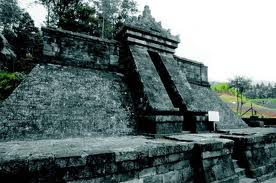Minggu, 15 Januari 2012
Sukuh and Cetho Temple
Cetho Temple
Cetho (Indonesian: Candi Cetho) is a fifteenth century Javanese-Hindu temple that is located on the western slope of Mount Lawu (elev. 900 m or 3,000 feet above sea level) on the border between Central and East Java provinces.
Ceto is one of several temples built on the northwest slopes of Mount Lawu in the fifteenth century. By this time, Javanese religion and art had diverged from Indian precepts that had been so influential on temples styles during the 8-10th century. This area was the last significant area of temple building in Java before the island's courts were converted to Islam in the 16th century. The temples' distinctiveness and the lack of records of Javanese ceremonies and beliefs of the era make it difficult for historians to interpret the significance of these antiquities.[1]
It is close to Sukuh temple.
Sukuh Temple
Sukuh (Indonesian: Candi Sukuh Indonesian pronunciation: [ˈtʃandi ˈsukʊh]) is a 15th century Javanese-Hindu temple (candi) that is located on the western slope of Mount Lawu (elev. 910 m or 3,000 feet (910 m) above sea level) on the border between Central and East Java provinces.
Sukuh temple has a distinctive thematic reliefs from other candi where life before birth and sexual education are its main theme. Its main monument is a simple pyramid structure with reliefs and statues in front of it, including three tortoises with flattened shells and a male figure grasping his penis. A giant 1.82 m (6 ft) high of lingga (phallus) with four balls, representing penile incisions,[1] was one of the statues that has been relocated to the National Museum of Indonesia.
Architecture
A relief of yoni–lingga on the floor of the Candi Sukuh's entrance
The central main pyramid of the complex sits at the rear of the highest of three terraces. Originally, worshippers would have accessed the complex through a gateway at the western or lowest terrace. To the left of the gate is a carving of a monster eating a man, birds in a tree, and a dog, which is thought to be a chronogram representing 1437 CE, the likely date of the temple's consecration. There is an obvious depiction of sexual intercourse in a relief on the floor at the entrance where it shows a paired lingam which is represented physiologically by the (phallus) and yoni which is represented bodily by the (vagina). Genitalia are portrayed on several statues from the site, which is unique among Javanese classical monuments.
The main structure of Sukuh temple is like no other ancient edifice; a truncated pyramid reminiscent of a Maya monument and surrounded by monoliths and meticulously carved life-sized figures. A stone stairway rises through the front side of the pyramid to its summit. It is not known what the monument's unique shape was intended to symbolise. One theory is that it represents a mountain, however, why it replaced pre-existing forms of ancient Javanese temple design. There is no evidence that the main building supported a wooden structure. The only object recovered from its summit was a 1.82-metre lingga statue bearing an inscription and is now in the National Museum of Indonesia). The statue may once have stood on the platform over the stairway. The lingga statue has a dedicated inscription carved from top to bottom representing a vein followed by a chronogram date equivalent to 1440. The inscription translates "Consecration of the Holy Ganges sudhi in ... the sign of masculinity is the essence of the world."[3] Reliefs of a kris blade, an eight-pointed sun and a crescent moon decorate the statue.
On the wall of the main monument there is a relief portraying two men forging a weapon in a smithy with a dancing figure of Ganesha, the most important Tantric deity, having a human body and the head of an elephant. In Hindu-Java mythology, the smith is thought to possess not only the skill to alter metals, but also the key to spiritual transcendence.[5] Smiths drew their powers to forge a kris from the god of fire; and a smithy is considered as a shrine. Hindu-Javanese kingship was sometimes legitimated and empowered by the possession of a kris.
A headless life-sized male figure grasping penis
The elephant head figure with a crown in the smithy relief depicts Ganesha, the god who removes obstacles in Hinduism. The Ganesha figure, however, differs in some small respects with other usual depictions. Instead of sitting, the Ganesha figure in Candi Sukuh's relief is shown dancing and it has distinctive features including the exposed genitalia, the demonic physiognomy, the strangely awkward dancing posture, the rosary bones on its neck and holding a small animal, probably a dog. The Ganesha relief in Candi Sukuh has a similarity with the Tantric ritual found in the history of Buddhism in Tibet written by Taranatha.[5] The Tantric ritual is associated with several figures, one of whom is described as the "King of Dogs" (Sanskrit: Kukuraja), who taught his disciples by day, and by night performed Ganacakra in a burial ground or charnel ground.
Other statues in Candi Sukuh include a life-sized male figure with his hand grasping his own penis and three flattened shells of tortoises. Two large tortoise statues guard the pyramid entrance and the third one lies at some distance in front of the monument. All of their heads point to the west and their flattened shells may provide altars for purification rituals and ancestor worship.[3] In Hindu mythology, the tortoise symbolizes the base or support of the World and is an avatar of Vishnu, i.e. Kurma refer: Ocean of Milk.
Langganan:
Posting Komentar (Atom)









0 komentar:
Posting Komentar